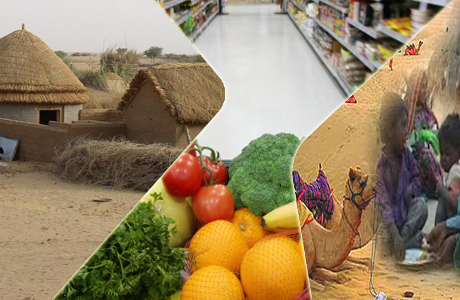Social side of food insecurity
By: BR Research
 Successive
governments in Pakistan have been fond of taking credit for
high agriculture produce, especially in staple crops like
wheat, rice and sugarcane.
Successive
governments in Pakistan have been fond of taking credit for
high agriculture produce, especially in staple crops like
wheat, rice and sugarcane.
But they are usually clueless about why, then,
Pakistan has very high incidence of food insecurity.
Various estimates converge towards a damning indictment
that Pakistans food insecurity rate is more than 50 percent
- that is, every second Pakistani is food insecure.
And that the incidence is growing due to population
growth and economic hardships.
Many people now realize that it is fallacious to argue that
high staple production will inevitably lead to optimal
consumption in the society. But the problems run deeper than
that.
The ongoing three-day SDPI conference in Islamabad (Pathways
to Sustainable Development) prominently placed food security
in its agenda.
Yesterdays food security sessions yielded several insights
on social dimensions of the problem.
Some glaring problems stand out. First is the gender
disparity dimension. Almost half of Pakistans population is
female and roughly the same the incidence of food
insecurity.
There could be some correlation between these two variables
in a patriarchal society like Pakistans, though there is no
study to pinpoint whether a relationship exists or how
strong the association is.
But experts point out that
low-income and low-educated households tend to prioritize
their food baskets for male household members, who are seen
as the main breadwinners.
Beyond affecting the female
populations ability to be active members of the society,
what this household-level inequity does, is that it leaves
females food-deficient, which sets up the stage where
newborns may also be vitamin-deficient.
Result could be in various
forms of malnutrition that later haunt a whole generation of
kids.
Second is the perennial
nature of conflicts and disasters in Pakistan which threaten
any hard-earned gains made towards food access and poverty
alleviation.
For instance, floods in
Punjab and Sindhs plains and rangelands are now occurring
almost every year. The governments have largely been
negligent in disaster-risk-reduction and post-event
rehabilitation response.
But part of the blame also lies with the affectees who
continue to refuse to settle away from flood-prone danger
zones or refuse to evacuate when floods are about to hit
their establishments.
That behaviour is explained
due to the tough socioeconomic conditions of affectees, who
are more likely to be marginalised people. Deluged
communities mean that people have to take shelter far away
with limited food availability (if they e lucky).
Third is the social influence of the mythical or real
"middleman".
Despite substantial increases
in the support prices for wheat and other staples since
2008, the farmers organizations are suggesting that small
growers are yet to see the price impact on their sales.
Meanwhile, city dwellers have
faced the brunt of high prices for flour, sugar, rice and
vegetable.
Between hungry growers and wary urbanites is the middleman
and his squeeze, experts say. That middleman is definitely
entrenched in farmlands on one hand, and in power corridors
on the other.
But the status quo has
probably gone on for so long because small farmers haven
been able to, for whatever reasons, come around to the idea
of farming collectives on a large scale. Maybe growers
should be more collaborative for their common good.
The concluding point here is that yes, the government should
take the major blame here for a population that is
increasingly growing but not getting adequate calorific
intake.
But that alone cannot
adequately explain the whole problem. There are social
dimensions at work too, few of which are highlighted above.
The state should reflect and act on the grave food
insecurity issues, but so should the society.
December, 2014
Source: Business
Recorder